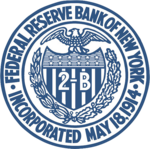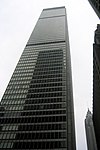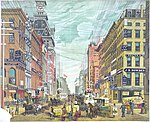Federal Reserve Bank of New York Building

The Federal Reserve Bank of New York Building, also known as 33 Liberty Street, is a building in the Financial District of Manhattan in New York City, which serves as the headquarters of the Federal Reserve Bank of New York. The building occupies the full block between Liberty, William, and Nassau Streets and Maiden Lane; it narrows at its east end, following the footprint of the block. The Federal Reserve Building has fourteen above-ground stories and five basement levels, designed by York and Sawyer with decorative ironwork by Samuel Yellin of Philadelphia. Its facade is separated horizontally into three sections: a base, midsection, and top section. The stone exterior is reminiscent of early Italian Renaissance palaces such as Florence's Palazzo Strozzi and Palazzo Vecchio. The horizontal and vertical joints of the facade's stones are deeply rusticated. The Federal Reserve Building's gold vault rests on Manhattan's bedrock, 80 feet (24 m) below street level and 50 feet (15 m) below sea level. The vault contains the largest known monetary-gold reserve in the world, with about 6,190 short tons (5,620 metric tons) in storage as of 2019. The building was erected from 1919 to 1924, with an eastward extension built in 1935. The Federal Reserve Building's design and scale was largely praised upon its completion. The building was designated a city landmark by the New York City Landmarks Preservation Commission in 1966 and was added to the National Register of Historic Places (NRHP) in 1980. It is a contributing property to the Wall Street Historic District, an NRHP district created in 2007.
Excerpt from the Wikipedia article Federal Reserve Bank of New York Building (License: CC BY-SA 3.0, Authors, Images).Federal Reserve Bank of New York Building
Liberty Street, New York Manhattan
Geographical coordinates (GPS) Address Website Nearby Places Show on map
Geographical coordinates (GPS)
| Latitude | Longitude |
|---|---|
| N 40.708333333333 ° | E -74.008611111111 ° |
Address
Federal Reserve Bank of New York
Liberty Street 33
10045 New York, Manhattan
New York, United States
Open on Google Maps










